Food preservation techniques have led to an increase in the longevity or shelf life of food items by introducing different ways of preserving methods. Its study is not only important in the field of food science, but also in daily lives, to set up food businesses etc.
The methods of food preservation include some inexpensive traditional and modern methods. We can safely retain the food quality or increase the shelf life through the different food preservation methods like drying, freezing, canning, salting etc.
Content: Food Preservation Techniques
Definition of Food Preservation
Food preservation can define as the process through which one can store the food products for longer period of time by employing different ways of food preserving techniques like, drying, salting, sugaring, freezing, canning etc. Food preservation is a branch of science, which targets food edibility and quality by preventing food decay. Besides, it also focuses on the shelf-life of food products so that the food can be preserved in a fit condition for future use and along with that also ensures food safety by either restricting or destroying the microbial growth.

Principle of Food Preservation
The principle of food preservation includes prevention against microbial decomposition, prevention of self-decomposing foods, and prevention against the various chemical, physical and mechanical damage of the food.
- Prevents or delay of microbial decomposition: It either involves inhibition of microbial growth (microbiostatic) or killing of microorganisms (microbicidal). Food preservation maintains asepsis, which means “keeping out microbes” by eliminating or filtrating microbes. It restricts microbial growth by various methods like chilling, freezing, smoking etc. and destroys microorganisms by methods like pasteurization, irradiation etc.
- Prevents self-decomposition of food items: It either involves inactivation of food enzymes by methods like pickling, salting, sugaring etc. or elimination of pro-oxidants by using antioxidants.
- Prevents damage caused by physical, chemical and mechanical damage by the factors like rancidity, flavour encapsulation, bruising etc.
Video: Food Preservation Techniques
Objectives
Food preservation methods include the following objectives:
- Ensures the edibility of food by preventing pathogenic organisms or chemicals.
- Prevents bacterial and fungal growth in food products.
- Keeps the quality, including colour, texture, flavour etc. and nutritive value of the food products remain intact.
- Retards the oxidation of fats to reduce rancidity.
- Prevents food from discolouration or ageing.
- Seals the preserved food to keep away the pathogenic microbes.
Common Methods of Food Preservation
Food preservation technique can be categorized into two classes, namely physical and chemical means of preserving food.
Physical Methods
Food can be preserved by physical methods like:
Drying
It is also called dehydration method, which removes the moisture content of the food naturally by the sunlight. Drying method was popular from the ancient times, where people used to dry various spices, vegetables and fruits etc. through the effective solar light.
We must have heard about the sundried tomato that has been originated from Southern Italy, which is known for its deliciously sweet taste.
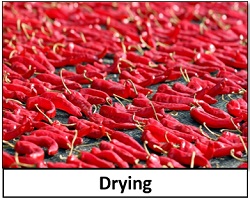
In India, also drying method has been used for food products like apple, mango, chillies, herbs, different spices etc. Drying method involves exposure of food items to the direct sunlight on the clean, dry place for up to two weeks or more. Nowadays, an electric dehydrating machine is also used as an artificial method of drying.
Chilling
It is also called the refrigeration method, which is most commonly used in this modern generation. Chilling is a simple method, which makes the use of cold temperature (1-4 degrees Celsius) to store the food for a few days to a few weeks depending upon the food content, food type etc. The cold temperature holds back the microbial growth, and so minimizes the food spoilage.
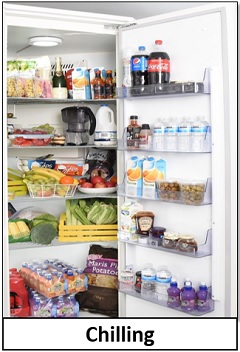
Things like food storage, food containers, fridge temperature etc. are the factors which we must keep in mind before refrigeration. The use of sterilized containers, storage of food items on particular shelves, discarding of decayed food and the temperature between 1 to 4 degrees Celsius can increase the food longevity.
Freezing
It is an advance method over chilling. Freezing method makes the use of freezing temperature to preserve various food items, which can increase the longevity for up to a few weeks to a month. Microorganisms rarely grow at a freezing temperature. Like chilling, freezing also uses certain measures to increase the shelf life of food items such as food storage, freezing temperature and defrosting.

Food stored in airtight containers, freezing temperature between -18 to -20 degrees Celsius and regular defrosting are the factors, which can increase the shelf life for at least 1 month.
Canning
It is also called bottling, in which different kinds of canner are used to sterilize the jars and the food material kept in it. Water bath canners are generally used to store high acid foods, and pressure canners are used for low acid foods. In the process of canning, different food items like vegetables, fruits, fish, meat etc. are first processed then stored inside a sterilized jar or can.

Finally, the jars are sealed by a top lid, and it can be labelled with the information like date of processing and the name of the food item. Sir Nicholas Appert was a scientist, who is known as “Father of Canning”.
Smoking
It is a conventional method of food preservation, which makes the use of smoke released by burning a type of wood. The formaldehyde and the phenolic compounds of the wood add unique flavour to the smoked food items. The smoking method is now generally used for fish and meats. It preserves the food through the antimicrobial properties of the formaldehyde and phenolic compounds and through heating, the food product dries up.

Pasteurization
It is known after the name of a scientist “Louis Pasteur” who introduced that the food can be spoiled when exposed to the air. Air contains numerous microbes, which can deteriorate the physiochemical properties of the food. The process of pasteurization makes the use of high heat to destroy or deactivate the pathogenic microorganisms.
Commonly, there are three pasteurization methods known, namely VAT, HTST and UHT. The VAT or LTLT method comes under the category of batch pasteurization, whereas HTST and UHT methods come under the category of flash pasteurization. VAT pasteurizes the food items comparatively at a lower temperature for a long time. Oppositely, HTST and UHT method pasteurize the food items at relatively high temperature for a short time.

HTST or high-temperature short time works under 161 degrees F for 16 seconds, while UHT or ultra-high temperature works under 280-302 degrees F for up to 1-2 seconds. Pasteurized products like milk, cheese, butter, juices etc. have a long shelf life, but once the package is opened, then it must be kept inside the refrigerator.
Chemical Methods
Food can also be preserved by chemical methods like:
Sugaring
It is a common method of preserving food items by the addition of sugary substances to reduce the moisture content. Sugaring is mostly used for the preservation of fruits like cranberries, mango, apricots etc. commonly called jam. The addition of sugar into the fruits increases sugar concentration, which causes the food item to release its water content and prevents against microbial attack.
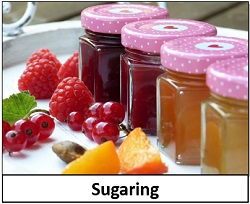 All the sugary substances like sugar syrup, sugar granules, honey, jaggery etc. can be used in this method. Besides fruits, vegetables like ginger and carrots can also be preserved by sugaring and further can be used as condiments.
All the sugary substances like sugar syrup, sugar granules, honey, jaggery etc. can be used in this method. Besides fruits, vegetables like ginger and carrots can also be preserved by sugaring and further can be used as condiments.
Salting
Salting is one of the food preservation methods, which principle is very much similar to the method of sugaring. The addition of salt results into the release of water content from the desired food and so prevents against the harmful microorganisms that can make the food unappetizing. Salting can be done in two ways, namely dry and wet curing. In dry curing, the dry salt is added into the food items like fish, meat, chicken etc. to draw water out of it.
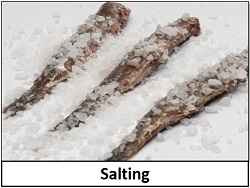
Oppositely in wet curing, a salt or brine solution is prepared to keep various vegetables for a longer time by following the canning method. Sugaring and salting are the kinds of food preservation techniques, which need special attention as excessive salt and sugar may cause health risks.
Pickling
It is one of the ancient time food preservation methods, which can be of two types (fermentation and chemical pickling). The pickling method makes the use of natural preservatives like salt, edible oil, sugar, and spices etc. and chemical preservatives like EDTA. Vegetables like garlic, onion, cucumber, carrot, ginger etc. can be fermented by adding them into a brine solution or vinegar.
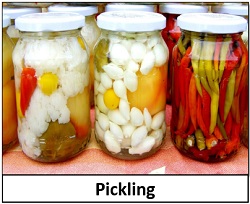
In modern days, food additives like EDTA are added to further increase the longevity of food products and the process known as “Chemical pickling”. Pickles generally have a shelf life of one to two years.
Importance
Food preservation techniques hold huge importance to keep the food for longer duration without altering the food texture, odour and the nutrient content.
Prevents pathogenic growth: Food preservation technique prevents the microbial growth of E. coli, Salmonella species, Aspergillus species, Mucor species etc. to minimize the chances of food spoilage and food infection. Microbes utilize the food moisture and the nutritive content of the food material to multiply its growth.
As a result, the food material will become inedible for human consumption. Therefore, we need to employ the desired food preservation method to keep the food for a longer time without any microbial attack.
Maintains food quality: Over a period of time, the food products generally degrade by many factors such as a microbial attack, chemical and mechanical damage. It mainly alters food quality by changing the food colour, texture, odour etc. By properly following the safe guides, we can employ various food preservation techniques to retain the food quality along with the intact nutrient content.
Inexpensive method: The traditional methods of food preservation are inexpensive for the setup. Methods like sun drying, pickling, salting, sugaring etc. do not require high capital costs, as the process is natural. It does not need any artificial additives and machinery to increase food longevity.
Conclusion
Therefore, we can conclude that food preservation techniques provide the best way to store different food items. The motive of food preservation is to retard the microbial growth and to extend shelf life of the food by maintaining food safety and food quality.

Your articles are pretty informative for the school project.